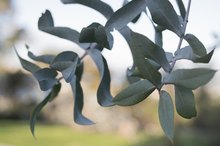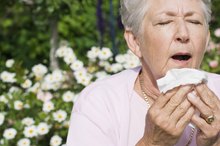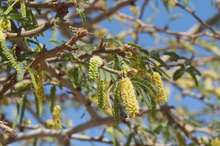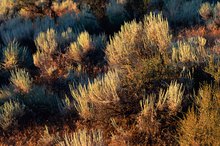Cedar Allergy Symptoms
Cedar allergy, or cedar fever, is a form of seasonal allergic rhinitis that shares the usual hay fever symptoms. Some types of cedar trees produce especially prolific amounts of allergenic pollen; Japanese cedar, mountain cedar, and Eastern and Western redcedars actually belong to the juniper and cypress families but are commonly classed as cedars in the United States. Although most cedars pollinate and cause allergy symptoms in the spring, the mountain cedar of the south central U.S. states reproduces in the winter and may cause severe allergic rhinitis.
Eye Symptoms
Winter or spring symptoms in hay fever patients may be caused by cedar or another airborne tree pollen, which affects the mucous membranes of the body. Itchy, red, teary eyes may result, as well as inflammation of the eyelids. Eyelids may swell, and under-eye areas may darken.
These allergy symptoms are triggered by histamine, a substance produced in abnormal reaction to the ingestion of cedar pollen, the Cleveland Clinic reports 1. Tiny cedar pollen granules can travel through the breeze and stick to unprotected eyes, inducing further irritation. Because of this tree pollen’s long-distance mobility, cedar allergy symptoms can occur in areas outside the growing range.
- Winter or spring symptoms in hay fever patients may be caused by cedar or another airborne tree pollen, which affects the mucous membranes of the body.
- Tiny cedar pollen granules can travel through the breeze and stick to unprotected eyes, inducing further irritation.
Nose Symptoms
Juniper Allergy Symptoms
Learn More
Nasal symptoms and breathing problems constitute the most disturbing effects of allergic rhinitis. According to the Allergy, Asthma and Immunology Clinic of Georgetown, Texas, these effects create a domino effect, setting off other health problems that can combine to significantly disable patients.
A runny nose develops when hay fever histamine sends fluid into the mucous membranes. Excess mucus in the nasal passages can drain into the sinus cavities and the throat. Inflammation causes mucus to accumulate in and congest the airways, creating a stuffy nose. Sneezing may become forceful in an attempt to clear the nasal passages of mucus and cedar pollen.
- Nasal symptoms and breathing problems constitute the most disturbing effects of allergic rhinitis.
- Sneezing may become forceful in an attempt to clear the nasal passages of mucus and cedar pollen.
Throat Symptoms
Histamine-induced itching also affects the mouth and throat, states the University of Maryland Medical Center (UMMC) 2. People with allergic rhinitis may clear their throats frequently, irritating and inflaming the membranes. As the mucus from postnasal drip contacts this tissue, a sore throat and cough may develop.
Facial and Sleep Symptoms
What Are the Allergy Symptoms to Eucalyptus Pollen?
Learn More
The stress of coughing and sneezing plus the pressure from sinus inflammation can lead to facial tenderness accompanied by headaches. Some hay fever discomforts make sleep difficult, and the sneeze reflex, in particular, interrupts deep sleep. The UMMC states that fatigue and facial pain may arise from the combined stress of other cedar allergy symptoms.
Related Articles
References
- Cleveland Clinic: Hay Fever
- University of Maryland Medical Center: Allergic Rhinitis
- PDQ Integrative, Alternative, and Complementary Therapies Editorial Board. Aromatherapy With Essential Oils (PDQ®): Health Professional Version. 2019 Oct 25. In: PDQ Cancer Information Summaries. Bethesda (MD): National Cancer Institute (US); 2002-.
- Rajmohan V, Mohandas E. The limbic system. Indian J Psychiatry. 2007;49(2):132-9. doi:10.4103/0019-5545.33264
- PDQ Integrative, Alternative, and Complementary Therapies Editorial Board. Aromatherapy With Essential Oils (PDQ®): Health Professional Version. 2019 Oct 25. In: PDQ Cancer Information Summaries [Internet]. Bethesda (MD): National Cancer Institute (US); 2002-.
- Sánchez-vidaña DI, Ngai SP, He W, Chow JK, Lau BW, Tsang HW. The Effectiveness of Aromatherapy for Depressive Symptoms: A Systematic Review. Evid Based Complement Alternat Med. 2017;2017:5869315. doi:10.1155/2017/5869315
- Hay IC, Jamieson M, Ormerod AD. Randomized trial of aromatherapy. Successful treatment for alopecia areata. Arch Dermatol. 1998;134(11):1349-52. doi:10.1001/archderm.134.11.1349
- Barnard DR. Repellency of essential oils to mosquitoes (Diptera: Culicidae). J Med Entomol. 1999;36(5):625-9. doi:10.1093/jmedent/36.5.625
- Takeda A, Watanuki E, Koyama S. Effects of Inhalation Aromatherapy on Symptoms of Sleep Disturbance in the Elderly with Dementia. Evid Based Complement Alternat Med. 2017;2017:1902807. doi:10.1155/2017/1902807
- Orchard A, Van vuuren S. Commercial Essential Oils as Potential Antimicrobials to Treat Skin Diseases. Evid Based Complement Alternat Med. 2017;2017:4517971. doi:10.1155/2017/4517971
- Barnard DR. "Repellency of essential oils to mosquitoes (Diptera: Culicidae)." J Med Entomol. 1999 Sep;36(5):625-9.
- Hay IC, Jamieson M, Ormerod AD. "Randomized trial of aromatherapy. Successful treatment for alopecia areata." Arch Dermatol. 1998 Nov;134(11):1349-52.
Writer Bio
Nancy Clarke began writing in 1988 after achieving her Bachelor of Arts in English and has edited books on medicine, diet, senior care and other health topics. Her related affiliations include work for the American Medical Association and Oregon Health Plan.








